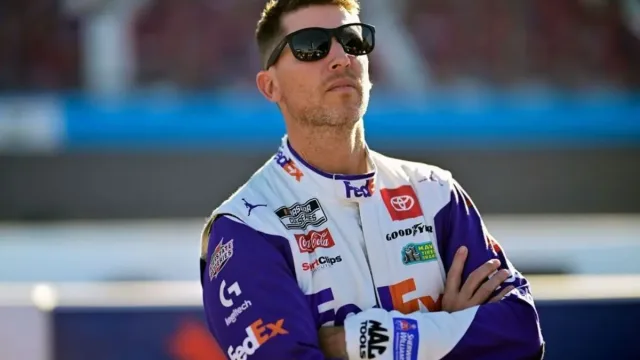Key Takeaways
- Denny Hamlin aimed for a historic fourth Daytona 500 win but faced setbacks during the crucial overtime period.
- A sudden wreck, influenced by Joey Logano’s miscalculation, shifted race dynamics, impacting Hamlin’s chances.
- NASCAR’s decision not to issue a caution flag after Riley Herbst’s spin created chaos among drivers.
- Hamlin expressed frustration over inconsistent officiating, questioning NASCAR’s decision-making amidst intense moments.
- Despite setbacks, Tyler Reddick’s strong performance provided a silver lining for 23XI Racing, focusing on future races.
Joey Logano’s Early Dominance and Sudden Setback
Joey Logano surged ahead early in the Daytona 500, exhibiting a remarkable blend of speed and skill that captivated fans and competitors. His race strategy seemed flawless, as he consistently maintained Logano’s speed, drawing praise from the stands and raising fan expectations for a possible victory.
However, the race took a dramatic turn when a sudden wreck analysis revealed that Logano’s miscalculation resulted in a notable loss of momentum, not only affecting his own chances but also leading to a chain reaction that ensnared Ryan Blaney.
This unforeseen setback shifted the focus of the race, elevating Denny Hamlin and Austin Cindric as new contenders, demonstrating how quickly momentum shifts can alter the dynamics of racing.

Hamlin’s High Hopes for a Fourth Daytona Win
As the race unfolded and Joey Logano’s early dominance faded due to unforeseen circumstances, Denny Hamlin found himself at the forefront of the Daytona 500, with his sights firmly set on a historic fourth victory.
Positioned in the front row as the event converted into overtime, Hamlin’s strategy revolved around leveraging his experience and understanding of race dynamics to maintain his lead.
The mounting strain of overtime intensified, yet he remained unfazed, embodying the tenacity crucial for a driver with a growing Daytona legacy.
Fans, fully invested in his pursuit, displayed a spectrum of emotions, from hopeful anticipation to anxious anxiety, highlighting the significant stakes of the moment.
Unforeseen Turn of Events: No Caution Flag
In motorsport, the essence of chance can often dictate the fate of even the most seasoned competitors. As Hamlin raced toward what he believed would be a crucial moment, the unexpected absence of a caution flag following Herbst’s spin shattered his race strategy.
Unlike the previous day’s Xfinity Series event, where a comparable scenario had prompted immediate caution, NASCAR’s decision not to intervene left drivers grappling with heightened tensions. Hamlin’s fierce competition with Austin Cindric intensified, while Cole Custer’s miscalculation ultimately led to a disastrous wreck.
Amidst this chaos, William Byron seized the opportunity, winning his second consecutive Daytona 500, leaving fans and drivers questioning NASCAR rules and the implications for future races.

Hamlin’s Frustration and NASCAR’s Inconsistent Calls
Frustration permeated Hamlin’s post-race reflections as he grappled with what he viewed as NASCAR’s inconsistent officiating decisions.
“I need to see the other wrecks, but I knew they were wrecking. We were surprised that they kept going. Once I realized that they are not gonna throw yellow, all I was focused on then was let me get a run on this 2 (Austin Cindric), get beside them, and win this race. And then apparently, I think they went green all the way to the checkered right. So I mean I was destroyed.” – (hamlin)
Hamlin’s officiating concerns centered around the sanctioning body’s reactionary policies, which he believed were shaped markedly by public backlash impact. He pointed to the previous season’s Damaged Vehicle Policy as a prime example of how NASCAR’s inconsistency in rules often leads to confusion among competitors.
“They’ll react. When they feel like if they get trashed, socially, on a call, they will over-go the other way on the next one.” – (hamlin)
Hamlin criticized NASCAR’s reactionary policies, highlighting how public backlash influences inconsistent rule enforcement and confuses competitors.
This inconsistency undermines the integrity of the sport and raises questions about future officiating changes. Hamlin’s critique highlights a broader issue within NASCAR, where the desire for a swift response to fan discontent may inadvertently compromise the consistency necessary for fair competition.
Silver Lining for 23XI Racing
While Hamlin faced disappointment following the Daytona 500, a silver lining emerged for 23XI Racing through the impressive performance of his teammate, Tyler Reddick.
Reddick’s ability to navigate the chaos and secure a runner-up finish emphasized strong team dynamics, reflecting the potential for collaboration in future strategies.
As Hamlin turns his focus to the upcoming Atlanta race, he recognizes the significance of this event in the context of playoff implications, aiming to secure a victory that could lock him into the 2025 playoffs early.
The challenges posed by Atlanta’s unique track conditions will test Reddick and Hamlin, but their recent performance suggests that 23XI Racing is ready to adapt and thrive under stress.

News in Brief: Denny Hamlin’s Daytona 500 Dreams
Denny Hamlin’s disappointment at the Daytona 500 encapsulates the unpredictability of NASCAR, where a promising race can take a sudden turn amid chaos. Despite his frustration with the lack of a caution flag and the perceived inconsistencies in officiating, Hamlin’s performance highlights the competitive spirit of the sport.
As he and 23XI Racing shift their focus to future races, particularly Atlanta, the lessons learned from this tumultuous race may prove invaluable in their pursuit of victory.
ALSO READ: Denny Hamlin Sparks Daytona 500 Mayhem as Wreck Leaves Two Drivers in Shambles
